Perennial Flowers for Specific Uses in Oklahoma
A perennial is any plant that lives and flowers more than two years. Many of the plants below may be marginally hardy in northern locations of the state or in southern locations where summers are particularly hot. Some of the plants below are grown from bulbs or similar underground structures. Species marked with an asterisk need to be lifted each fall, stored over winter, and replanted the following spring. Consult with a reputable garden center or greenhouse for advice on perennials best suited for your particular location.
Cut Flowers
Below are a few of the more commonly grown species for use in arrangements and bouquets that are equally attractive in the flower garden. See Extension Fact Sheet HLA-6407 for ideas on flower arrangements and bouquets. Growers should refer to Extension Fact Sheet HLA-6426, “The Care and Handling of Cut Flowers.”
- Ageratum, Hardy (Eupatorium coelestinum)
- Astilbe (Astilbe x arendsii)
- Buby’s breath (Gypsophila paniculata)
- Bachelor’s buttons (Centaurea montana ‘Mountain Bluet’)
- Bee balm (Monarcla didyma)
- Blackberry lily (Belamcancla chinensis)
- Black-eyed Susan (Rudbeckia hirta var. pulcherrima)
- Bleeding heart (Dicentra eximia) (Dicentra spectabilis)
- Butterfly weed (Asclepias tuberosa)
- *Calla lily (Zantedeschia aethiopica)
- *Canna (Canna x generalis)
- Clematis, Jackman (Clematis x jackmanii)
- Columbine (Aquilegia hybrids)
- Coneflower (Echinacea purpurea)
- Coralbells (Heuchera sanguinea)
- Coreopsis (Coreopsis lanceolata)
- Dahlia (Dahlia hybrids)
- Daisy, Painted (Chrysanthemum coccineum)
- Daisy, Shasta (Chrysanthemum x superbum)
- Fountain grass (Pennisetum alopecuroides)
- Foxglove (Digitalis purpurea)
- Gaillardia (Gaillardia x grandiflora)
- Gayfeather (Liatris spp.)
- *Gladiolus (Gladiolus x hortulanus)
- Hollyhock (Alcea rosea)
- Iris, Bearded (Iris hybrids)
- Iris, Japanese (Iris ensata)
- Larkspur (Delphinium elatum)
- Lily, Garden (Lilium hybrids)
- Lily of the valley (Convallaria majalis)
- Maltese cross (Lychnis chalcedonica)
- Narcissus (daffodils) (Narcissus hybrids)
- Peony (Paeonia hybrids)
- Peony, Tree (Paeonia suffruticosa)
- Phlox, Tall (Phlox paniculata)
- Pincushion Flower (Scabiosa caucasica)
- Poppy, Iceland (Papaver nudicaule)
- Poppy, Oriental (Papaver orientale)
- Sage, Mealycup (Salvia farinacea)
- Salvia, Perennial (Salvia superba)
- Statice (Limonium latifolium)
- Sunflower, False (Heliopsis helianthoides var. scabra)
- Tulip (Tulipa hybrid)
- Yarrow, Fernleaf (Achillea filipendulina)
- Yarrow, Common (Achillea millefolium)
- Yarrow, Woolly (Achillea tomentosum)
Showy Foliage
These plants may be used to lend interest to surrounding flowering plants or for foliage in bouquets. Many of these species are equally striking when planted alone.
- Ajuga (Ajuga reptans)
- Bergenia (Bergenia cordifolia)
- Bishop’s goutweed (Aegopodium podagraria ‘Variegatum’)
- *Caladium (Caladium x hortulanum)
- Candytuft, Evergreen (Iberis sempervirens)
- *Elephant’s-ear (Colocasia esculenta)
- Fern, Christmas (Polystichum acrostichoides)
- Fern, Dragontail (Asplenium ebenoides)
- Fern, Lady (Athyrium filix-femina)
- Fern, Marginal shield (Dryopteris marginalis)
- Fern, Royal (Osmunda regalis)
- Fern, Sensitive (Onoclea sensibilis)
- Fescue, Blue (Festuca ovina ‘Glauca’)
- Grass, Fountain (Pennisetum alopecuroides)
- Grass, Plume (Erianthus ravennae)
- Hen-and-chickens (Sempervivum tectorum)
- Hosta (Hosta hyacintha)
- Japanese Blood Grass (Imperata cylindrica var. rubra ‘Red
Baron’) - Japanese Sweet Flag (Acorus gramineus ‘Variegata’)
- Lamb’s ear (Stachys byzantina)
- Lavender cotton (Santolina chamaecyparissus)
- Plantain lily, Wavy-leaved (Hosta undulata)
- Plantain lily (Hosta lancifolia var. albomarginata)
- Ribbon grass (Phalaris arundinacea var. picta)
- Rue (Ruta graveolens)
- Sedum (Sedum spp.)
- Yucca (Yucca filamentosa)
- Wormwood (Artemisia schmidtiana ‘Silver Mound’)
| Image | Caption | |
|---|---|---|
 |
Figure 1. Gayfeather (Liatris spp.) | |
 |
Figure 2. Iris (Iris hybrids) | |
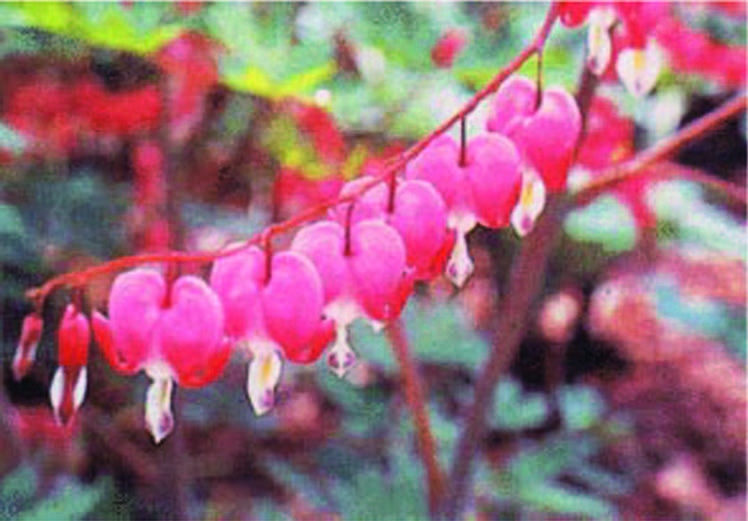 |
Figure 3. Japanese Bleeding Heart (Dicentra spectabilis) | |
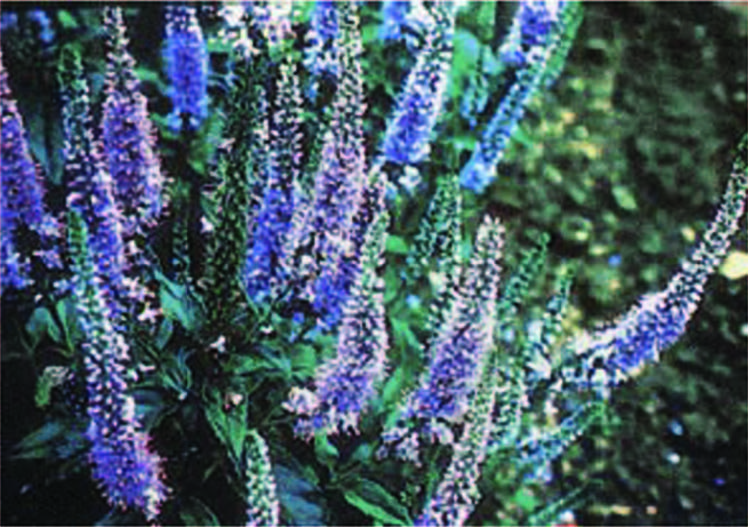 |
Figure 4. Spike Speedwell (Veronica spicata) | |
 |
Figure 5. Fragrant Plantain-Lily (Hosta plantaginea) | |
 |
Figure 6. Giant Onion (Allium giganteum) | |
 |
Figure 7. Garden Peony (Paeonia lactiflora) | |
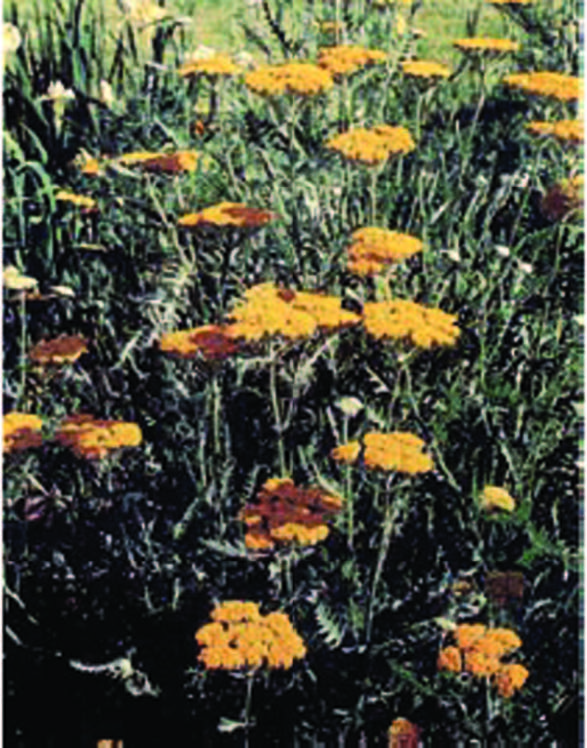 |
Figure 8. Ferlead Yarrow (Achillea filipendulina) | |
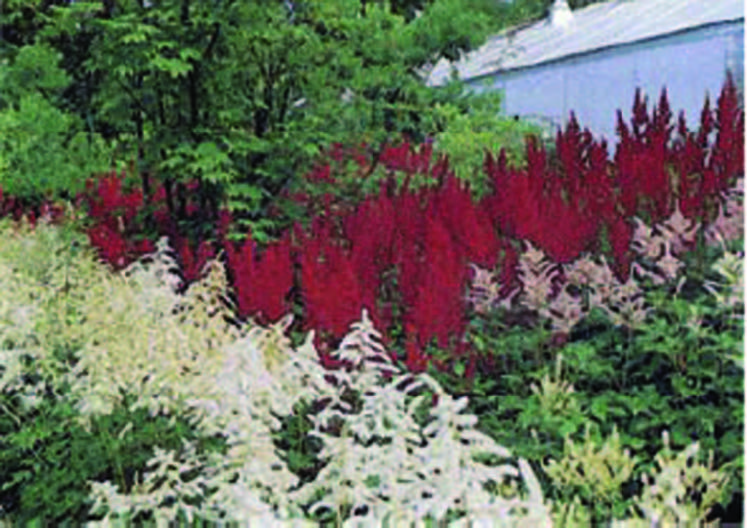 |
Figure 9. Astible (Astible x arendsii) | |
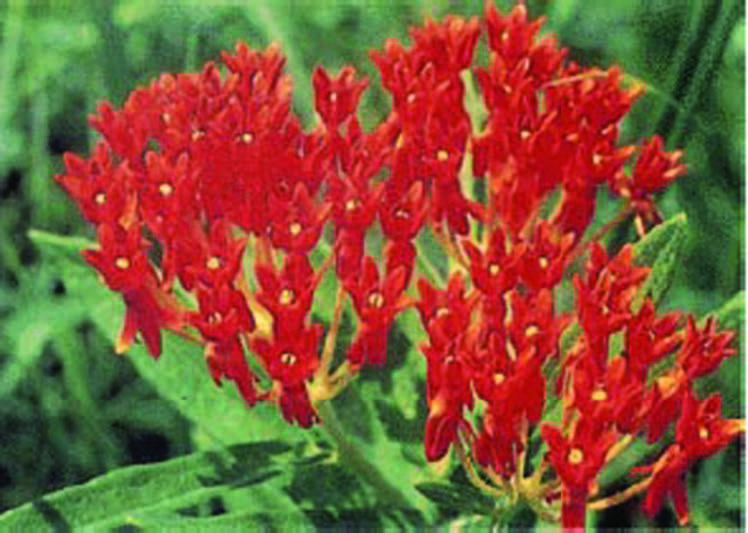 |
Figure 10. Butterfly Bush (Asclepias tuberosa) | |
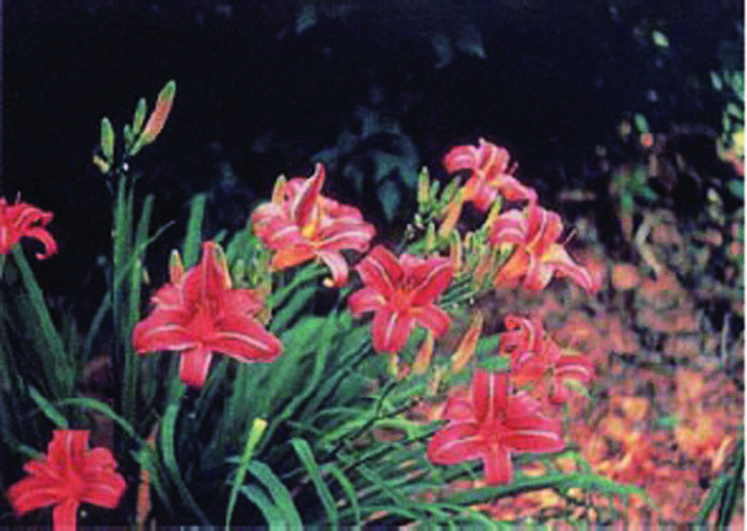 |
Figure 11. Daylily (Hemerocallis species) | |
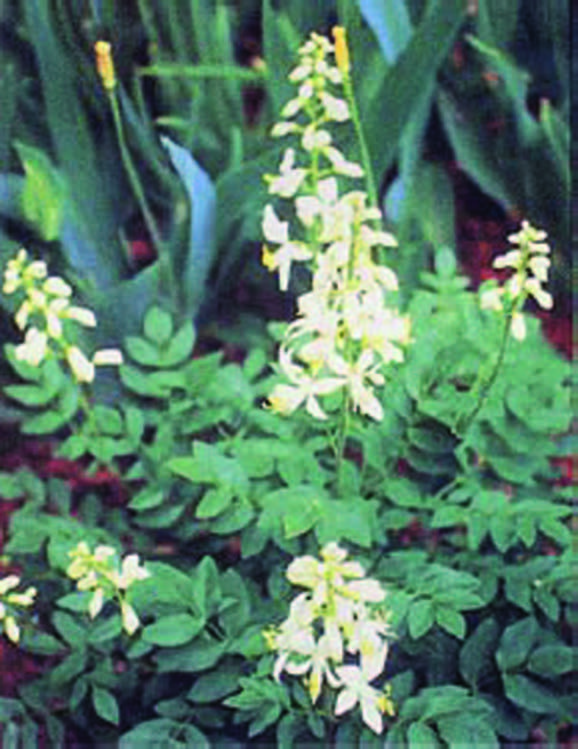 |
Figure 12. Gas Plant (Dictamnus albus) |
Large Background
Tall plants can serve as background for shorter perennials or annuals. These species may also be used as barriers to hide unsightly areas. Be certain when buying these plants that you get a tall cultivar and not a dwarf.
- Astilbe (Astilbe x arendsii)
- Baby’s breath (Gypsophila paniculata)
- Bee balm (Monarda didyma)
- Butterfly weed (Asclepias tuberosa)
- *Canna (Canna x generalis)
- Chrysanthemum, Hardy (Dendranthemum grandiflorom)
- Columbine (Aquilegia hybrids)
- Coneflower, Purple (Echinacea purpurea)
- Crown Imperial (Fritillaria imperialis)
- Daylily (Hemerocallis spp.)
- *Elephant’s-ear (Colotasia esculenta)
- Four O’Clocks (Mirabilis jalapa)
- Foxglove (Digitalis purpurea)
- Gas plant (Dictamnus albus)
- *Gladiolus (Gladiolus x hortulanus)
- Hibiscus (Hibiscus moschutos)
- Hollyhock (Alcea rosea)
- Indigo, False (Baptisia ausralis)
- Iris, Bearded (Iris hybrids)
- Jupitersbeard (Centranthus ruber)
- Lily, Garden (Lilium hybrids)
- Loosestrife (Lysimachia clethroides)
- Magic lily (Lycoris squamigera)
- Onion, Giant (Allium giganteum)
- Pampas grass (Cortaderia selloana)
- Peony (Paeonia hybrids)
- Peony, Tree (Paeonia suffruticosa)
- Phlox, Tall (Phlox paniculata)
- Red-hot poker (Kniphofia uvaria)
- Sedum (Sedum spectabile)
- Sneezeweed (Helenium autumnale)
- Sunflower, False (Heliopsis helianthoides var. scabra)
- Thistle, Small Globe (Echinops ritro)
- Yarrow (Achillea spp.)
- Yucca (Yucca filamentosa)
Prefer or Tolerate Light Shade
These plants may need protection from the sun. Many of these will suffer without protection from harsh Oklahoma conditions.
- Ajuga (Ajuga reptans)
- Astilbe (Astilbe x arendsii)
- Bergenia (Bergenia cordifolia)
- Bleeding heart (Dicentra eximia) (D. spectabilis)
- *Caladium (Caladium x hortulanum)
- Coralbells (Heuchera sanguinea)
- Daylily (Hemerocallis spp.)
- Fern, Dragontail (Asplenium ebenoides)
- Fern, Lady (Athyriun filix-femina)
- Fern, Royal (Osmumda regalis)
- Four O’Clocks (Mirabilis jalapa)
- Gloxinia, Hardy (Incarvillea delavayi)
- Hibiscus (Hibiscus moscheutos)
- Indigo, False (Baptisia australis)
- Lilac cranesbill (Geranium himalayense)
- Lily-of-the-valley (Convallaria majalis)
- Liriope (Liriope spicata)
- Moneywort (Lysimachia nummularia)
- Pachysandra (Pachysandra terminalis)
- Pasqueflower (Anemone pulsatilla)
- Plantain lily (Hosta spp.)
- Plumbago (Ceratostigma plumbaginoides)
- Solomon’s seal (Polygonatum biflorum)
- Spiderwort, Virginia (Tradescantia x andersoniana)
- Sweet woodruff (Galium odoratum)
- Violet, Sweet (Viola odorata)
Edging/Borders/Ground Covers
- Ajuga (Ajuga reptans)
- Bergenia (Bergenia cordifolia)
- Candytuft (Iberis sempervirens)
- Cinquefoil (Potentilla nepalensis)
- Crocus (Crocus hybrids)
- Crocus, Autumn (Colchicum autumnale)
- Fescue, Blue (Festuca ovina ‘Glauca’)
- Flax (Linum perenne)
- Fleeceflower, Reynoutria (Polygonum cuspidatum var.
compactum) - Glory of the snow (Chionodoxa luciliae)
- Goutweed, Bishop’s (Aegopodium podograria ‘Variegatum’)
- Grape hyacinths (Muscari album)
- Hen-and-chickens (Sempervivum tectorum)
- Lamb’s ear (Stachys byzantina)
- Lily-of-the-valley (Convallaria majalis)
- Liriope (Liriope spicata)
- Mallow, Poppy (Callirhoe involucrata)
- Moneywort (Lysimachia nummularia)
- Pachysandra, Japanese (Pachysandra terminalis)
- Pasque flower (Anemone pulsatilla)
- Penstemon (Penstemon spp.)
- Phlox, Moss (Phlox subulata)
- Plumbago (Ceratostigma plumbaginoides)
- Primrose, Missouri (Oenothera missouriensis)
- Sea pink (Armeria maritima)
- Sedum (Sedum spp.)
- Strawberry, Barren (Waldsteinia fragariodes)
- Squill, Siberian (Scilla siberica)
- Snowdrop (Galanthus nivalis)
- Violet, Sweet (Viola odorata)
- Violet, Horned (Viola cormuta)
Vines
The species below serve many purposes such as screening and can he grown on trellises, fences, and gazebos.
- Clematis, Jackman (Clematis x jackmanii)
- Everlasting Pea (Lathryus latifolius)
- Rose, Climbing (Rosa spp.)
Dried Flowers or Showy Fruit
Below are plants with flowers or fruit that can easily be dried for everlasting arrangements. Other species not listed may be suitable but require much more care for drying and preservation.
- Baby’s breath (Gypsophila paniculata) - flowers
- Blackberry lily (Belamcanda chinensis) - seed pods
- Butterfly weed (Asclepias tuberosa) - seed pods
- Chinese lantern plant (Physalis alkekengi) - seed pods Gayfeather (Liatris spp.) - flowers
- Indigo, False (Baptisia australis) - seed pods
- Money plant (Lunaria annua) - seed pods
- Pampas grass (Cortaderia selloana) - flower and seeds
- Quaking grass (Briza media) - flowers and seeds]
- Statice (Limonium latifolium) - flowers
- Thistle, Small globe (Echinops ritro) - flowers
- Yarrow (Achillea spp.) - flowers
Categories above are merely suggestions for placement of perennials. The categories are by no means comprehensive, but rather common uses for the specific plants listed. Check with personnel in your local greenhouse or garden center for additional advice on what plants perform well in your area. Also, bookstores often carry a wide array of books on gardening with perennials.
Books
Armitage, Allen. Herbaceous Perennial Plants. Varsity Press, Inc. Athens, Georgia. 1989.
Still, Steven M. Manual of Herbaceous Ornantental Plants. Stipes Publishing Company. 1988.
